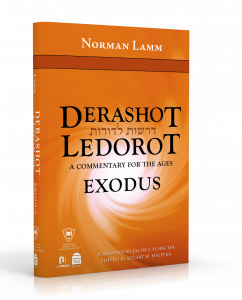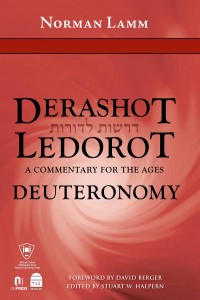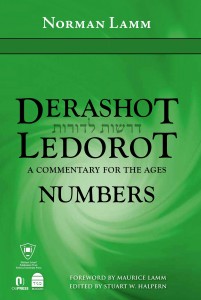Excerpted from Rabbi Norman Lamm’s Derashot Ledorot: A Commentary for the Ages — Exodus, co-published by OU Press, Maggid Publishers, and YU Press; edited by Stuart W. Halpern

Time, Space, and Man*
In our traditional Jewish literature, especially our Kabbalistic literature, all of life, experience, and existence are conceived of as consisting of three dimensions: olam, shana, and nefesh. Literally, these mean world, year, and soul. Actually, what is intended by these terms is Space, Time, and Man.
One of the distinguished rabbis of the State of Israel, Rabbi Shelomo Yosef Zevin, sees this triadic structure in the opening verses of today’s sidra. We read, “vayak’hel Moshe et kol adat Benei Yisrael,” that Moses assembled the entire congregation, and there he taught them the commandments of the Shabbat and Mishkan, the construction of the Tabernacle. The act of assembling all of Israel represents the element of nefesh of Man. The Mishkan is that which occupies a specific place. And Shabbat recurs every week, and hence represents the dimension of time.
It should be understood that this is not merely a way of describing the world or experience. It is a framework that has high spiritual significance, for it means that Judaism considers that these three elements interpenetrate each other and are interdependent.
This view teaches that, on the one hand, man needs the awareness of time and space; that is, he needs the spiritual implications and the consciousness of the spiritual potentialities, of both history and geography, the realms of shana and olam. Thus, Judaism speaks of kedushat hazeman, the sanctity of time, as in the celebration of Shabbat and the various festivals. And Judaism speaks too of kedushat hamakom, the holiness of place, as, for instance, the Mishkan or, today, the synagogue.
On the other hand, both time and space are significant in the divine economy only because of man, because of nefesh. Thus, Shabbat, which is a symbol of time, requires the participation of man (nefesh) in order to make it meaningful. According to the Torah, on the seventh day of Creation, God blessed the seventh day and sanctified it; nevertheless man was commanded, “Remember the Sabbath day to keep it holy,” i.e. man too must sanctify the seventh day. It is not enough that time be sacred on
its own; it requires the affirmation of man, the participation of his nefesh.
The same holds true of the category of space. The holiness of the Sanctuary is contingent upon the initiative of man. In the very commandment in which God makes known His will that we make a sanctuary for Him, we read: “ve’asu li mikdash veshakhanti betokham,” “and let them make Me a Sanctuary, that I may dwell among them.” Rabbi Moshe Alshikh observed that the expression is “betokham,” “among them,” and not “betokho,” “in it.” In other words, God did not want a Sanctuary because He was homeless and needed someplace to live. Rather, the Sanctuary, symbol of the sanctity of space, is important only because it allows man the opportunity to have God dwell within him, “betokho.” Thus, both time and space depend upon man. Olam and shana require nefesh.
This same pattern of Time, Space, and Man may be observed not only in our regular Torah reading for today, but also in the special reading for Parashat haĤodesh. We read this morning, “haĥodesh hazeh lakhem rosh ĥadashim,” that this month of Nisan is to be for us the chief of months. This means that Nisan is Rosh HaShana.
But do we not have another Rosh HaShana, one which begins on the first day of Tishrei? What then is the difference between the Rosh HaShana of Nisan and the Rosh HaShana of Tishrei?
The answer is that Rosh HaShanah of the fall, of Tishrei, is that of olam or Space, whereas the Rosh HaShana of spring, of Nisan, is that of shana or Time. In Tishrei we celebrate the anniversary of creation, of geography; this is the day on which God created the natural world. In Nisan we celebrate the Exodus from Egypt. We commemorate a great historical event, something that occurred in time and that made a difference for all time.
In both of these, Man, the possessor of nefesh, plays a crucial role. The two Rosh HaShana’s are not merely birthdays of mute nature, or anniversaries of some impersonal historical event. Rather, the Rosh HaShana of Tishrei emphasizes the element of din in which man is brought to the bar of divine justice. At this occasion we are told that man has within himself the capacity to overcome the limitations of the natural world, to transform the inexorable fate determined by the blind laws of nature. Thus, at the height and climax of our Rosh HaShana service in Tishrei, we proclaim, “uteshuva utefilla utzedaka ma’avirin et ro’a hagezera,” that by the exertion of his moral nature, by repentance and prayer and charity, man can actually change the decree of his future, the natural result of his conduct and misconduct in the past. So too, the Rosh HaShana of Nisan is not mere mechanical memorialization of some remote detached occurrence. It is a time of redemption, and therefore a signal for us that we are to strive for redemption during this month. Perhaps that is why we recite the “mi she’asah nisim” every Sabbath that we welcome or bless the new month. For the regular appearance of the new moon, on any month, now becomes the occasion to recall human redemption. Moreover, as the Rabbis pointed out, the Torah specifically tells us that, “haĥodesh hazeh lakhem rosh ĥadashim,” this month is “lakhem, “to you,” that is, the human court has the right to set the calendar and therefore to determine when the month of Nisan will fall. This is symbolic of the fact that the human element prevails, that man can determine what to do with his time, and hence with his fate and with his destiny. He can fashion his own history. In Judaism, Time, Space, and Man are inextricably bound together. This thesis has received remarkable confirmation by one of the most brilliant men alive today, Prof. R. Buckminster Fuller, inventor of the geodesic dome, in a recent address reprinted in the latest issue of The American Scholar. Prof. Fuller points out that for many years now scientists have maintained that the entire universe is running down. The energy within the world is dissipating into a kind of randomness, which means that everything is becoming successively more disorganized and chaotic and therefore the world, physically, must come to an end. Prof. Fuller points out, however, that there is an opposite tendency to this physical dissipation of the world, this “increase in entropy” – that is the activity of men on earth, and intelligent beings elsewhere in the universe, who by their intellectual and spiritual capacity constantly organize their lives, their thought, and their experience more and more sharply. This tendency to organize runs counter to the disorganization tendency within the material universe. Man, by his systematic intellect and his creative spirit, represents the opposite of the chaotic and the destructive. Hence, even from the point of view of a distinguished scientist, Man, through the exertion of his nefesh, may yet be the one who will save and redeem the world of olam and shana, of Space and Time!
It is a pity that we do not recognize that fact with sufficient force in our daily experience. Too often we underestimate the role of man in the world, the significance of nefesh in our universe. Symbolic of this failure is what happened a couple of years ago in Copenhagen, Denmark. A television station received many protests when it scheduled a program of bull-fighting. Many irate citizens wrote in that this was an example of cruelty which they resented. Thereupon the television station substituted for the bull-fighting program a film on war, consisting of naval battles. This time no one called in to protest!
The same is true of many of our humane societies who agitate for public acceptance of human laws – which is as it should be. Unfortunately, however, the same people who are so concerned about the welfare of animals, are totally oblivious to man’s cruelty to man – especially when the man who is the victim happens to be a Jew.
A more heartening example of the creative role of man in the world came in recent weeks when an Israeli citizen decided to make a dramatic gesture for peace by flying a small plane to Egypt to see President Nasser, and thereafter proceeding to Rome to see the Pope, then to Paris for President de Gaulle, and then probably on to the United States. It matters little whether or not his effort was motivated
by self-glorification, cheap publicity, or a general flair for self-projection. The important thing is that in this terrible Cold War, with great power blocks and stubborn nations locked in deadly hostility, controlled by giant bureaucracies, one single human individual was able to emerge from anonymity and obscurity to make his presence felt and move the hearts of his fellow men. The nefesh somehow prevailed, even momentarily, over the olam and the shana.
The time is long past for us to take a good, long, and deep look at Jewish education from the point of view of this triadic structure of Time, Space, and Man. I believe that the failure of so much of Jewish education to date is a result of the fact that there is olam and shana, but no nefesh. There is a place called “school” to which children are sent, and a certain time limit which they must serve, generally to Bar Mitzva. But there is all too little of the one element which can redeem the entire procedure and make it more meaningful and effective; the child, his nefesh, his own interest and heart and soul. Too often children feel that they merely “take up space” and “do time” as if they were juvenile convicts condemned to the agonizing boredom of Jewish education. What is needed is nefesh – and that can be provided by parents who understand that school is not a place to send children but to bring them, and that the home must serve not as a counter-pressure to school, but as a model laboratory where the principles and ideals taught in the Jewish school are carried out in practice. The teachers, too, must re-emphasize as never before the elements of the child’s own nefesh. A great deal of research is needed in Jewish education if all the investment we have put into it and all the dreams we have dreamed for it are to come true. Much too much of Jewish education today is irrelevant. It is simply a matter of relearning and re-teaching new techniques of instruction and pedagogy. What a pity if in this age of technological and methodological progress in so many fields Jewish education should remain backward and retrogressive. Parents, teachers, and the community at large must bring back nefesh to the Jewish educational world of olam and shana.
Finally, all three elements merge together in one paean of praise to Almighty God as we welcome the new month of Nisan this coming week. Man, indeed, has a positive function as a new season of the year comes about in which nature is aroused to life once again. The Talmud put it this way: When a man goes abroad in spring, and notices the trees blossoming and the first green blades of grass pushing their way through the crunchy earth, he ought to make a blessing to his God. He should say, “Blessed are thou O Lord, King of the Universe, shelo ĥisar be’olamo kelum, uvara bo beriot tovot ve’ilanot tovot, lehitanot bahen benei adam, who has made His world perfect, lacking nothing, creating therein beautiful creatures and wonderful trees, in order to grant thereby pleasure and joy and benefit to the children of men.”
With the coming of Nisan and spring, the fullness of God’s beautiful world, His olam, and the onset of the most delightful of His regular seasons of the shana, must be sanctified by the dedication and gratitude of human beings who, each possessed of a true nefesh, will offer to Him a berakha, and themselves be blessed thereby.
* March 19, 1966








